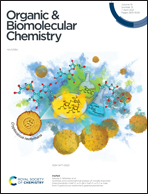Asymmetric synthesis of organophosphorus compounds using H–P reagents derived from chiral alcohols†
Abstract
Chiral organophosphorus compounds, especially those containing C-stereogenic carbons in the proximity of the phosphorus atom, are known for their unique properties and have found wide applications that span from medicinal chemistry to enantioselective catalysis. However, the synthesis of such chiral molecules, especially with the precise control of stereochemistry at chiral carbon atoms, still remains a very challenging task. This review summarizes recent advances in the highly stereoselective formation of C- and, in some cases, also P-stereogenic organophosphorus compounds. The presented synthesis strategy is based on the use of H–P reagents bearing TADDOL, BINOL or a menthol moiety attached to the phosphorus atom and serving as a chiral auxiliary. Reactions of such chiral H–P species with different partners, e.g., alkenes, alkynes, imines, and carbonyl compounds, leading to structurally diverse chiral organophosphorus compounds with up to five chiral centers are comprehensively discussed. In each case, the stereochemical outcome of the reaction is influenced by the presence of the chiral alcohol used; therefore, the content of this review is compiled into sections with respect to the type of chiral alcohol attached to the phosphorus atom in the H–P species applied.



 Please wait while we load your content...
Please wait while we load your content...